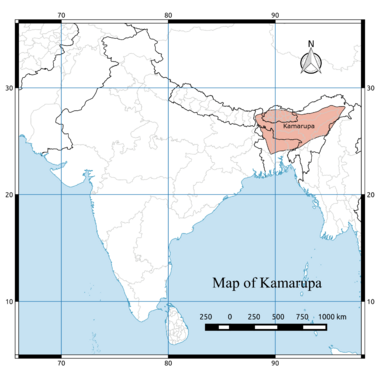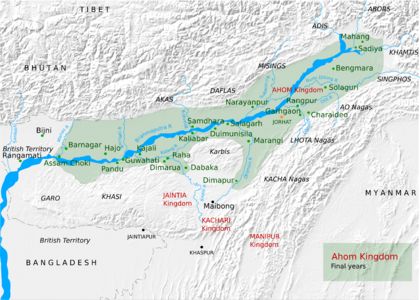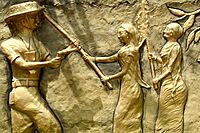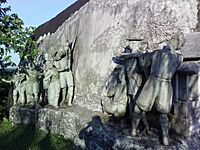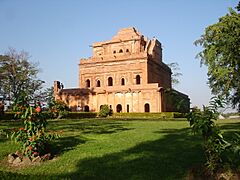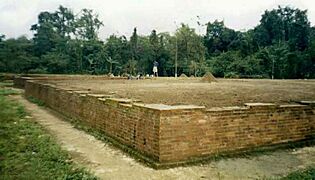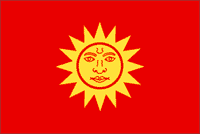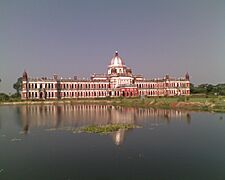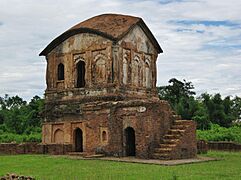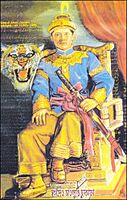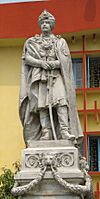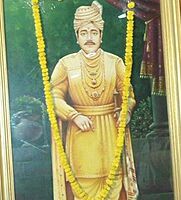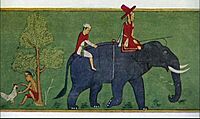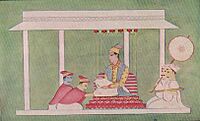History of Assam facts for kids
The history of Assam is like a big river where many different cultures and people have come together. People from the east, west, south, and north, including groups like the Austroasiatic, Tibeto-Burman, Tai, and Indo-Aryan, have all contributed to its story. Even though Assam was attacked many times over hundreds of years, it was never truly controlled by an outside power until the third Burmese invasion in 1821. After that, the British took over in 1824 during the First Anglo-Burmese War.
We learn about Assam's history from many places. The Ahom kingdom in medieval times kept special records called Buranjis. These were written in the Ahom and Assamese languages. For ancient Assam, we have Kamarupa inscriptions found on rocks, copper plates, and clay. These were like official announcements from the Kamarupa kings.
Assam's history can be split into four main periods. The ancient period started in the 4th century. This is when the Kamarupa kingdom was first mentioned in old writings, like those on the Allahabad pillar. The medieval period began around 1206 with attacks from the Bengal Sultanate, as seen in the Kanai-boroxiboa rock inscription. This was after the ancient kingdom broke apart and new kingdoms and local leaders appeared. The colonial period started when the British took control after the Treaty of Yandaboo in 1826. Finally, the post-colonial period began in 1947 when India became independent.
A common idea in medieval Assam's history is linked to a type of worship called shaktism and the famous Kamakhya temple.
Contents
Ancient Times: The First Kingdoms (350–1206)
The recorded history of Assam really begins in the 4th century. This is when Pushyavarman started the Varman dynasty in the Kamarupa kingdom. This kingdom grew to cover a large area, from the Karatoya River in the west to Sadiya in the east. The Varman dynasty and the two dynasties that followed believed they were related to the mythical hero Narakasura.
The Kamarupa kingdom was strongest under Bhaskaravarman in the 7th century. A famous traveler named Xuanzang visited his court and wrote a lot about what he saw. When Bhaskaravarman died without children, Salasthamba took over and started the Mlechchha dynasty.
After the Mlechchha dynasty ended in the late 9th century, a new ruler named Brahmapala was chosen. He started the Pala dynasty. The last Pala king was removed by the Gaur king, Ramapala, in 1110. However, the next two kings, Timgyadeva and Vaidyadeva, mostly ruled on their own, even though they were set up by the Gaur kings. They even used the old Kamarupa seals for their official documents.
The Kamarupa kingdom eventually broke up into smaller, individual kingdoms in the 12th century. This marked the end of the ancient period in Assam.
Medieval Times: New Kingdoms Rise (1206–1826)
See: Kamata kingdom, Ahom kingdom, Chutiya kingdom, Kachari kingdom, Bhuyan chieftains.
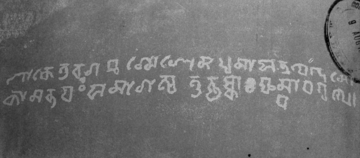
Around the mid-13th century, a king named Sandhya moved his capital to Kamatapur. This is how the Kamata kingdom began, mainly because of attacks from Bengali forces. The last kings of Kamata, known as the Khens, were removed by Alauddin Hussain Shah in 1498. But Hussain Shah and later rulers couldn't keep control of the Kamata kingdom. This was mostly due to revolts by the Bhuyan chieftains, who were local leaders, and other groups.
Soon after, in the early 16th century, Vishwa Singha from the Koch tribe started the Koch dynasty in the Kamata kingdom. This dynasty became very powerful under his sons, Nara Narayan and Chilarai.
In the eastern part of what is now Assam, two other kingdoms appeared: the Kachari kingdom (in central Assam, south of the Brahmaputra River) and the Chutiya kingdom (in eastern Assam, north of the Brahmaputra River). Some Bhuyan chieftains controlled the area just west of the Chutiya kingdom. In the land between the Kachari and Chutiya kingdoms, a group of Shan people, led by Sukaphaa, established the famous Ahom kingdom.
The 16th century was very important. The Ahoms became strong in the east, taking over the Bhutiya kingdom and pushing the Kachari kingdom away from central Assam. The Koch kingdom grew in the west. Also, the Ekasarana Dharma, a new religious movement started by Srimanta Sankardev, became very popular.
After Nara Narayan of the Koch dynasty died in the late 16th century, the Kamata kingdom split into two parts: Koch Bihar in the west and Koch Hajo in the east. These two kingdoms became rivals. Koch Bihar allied with the Mughals, while Koch Hajo allied with the Ahoms.
Most of the 17th century saw many battles between the Ahoms and the Mughals. The Ahoms successfully defended their land against the powerful Mughals, famously winning the Battle of Saraighat in 1671. These conflicts finally ended in 1682 when the Mughals were defeated at Itakhuli in Guwahati. The Ahom kingdom then reached its western border at the Manas River, which it kept until 1826. Even though the Ahom kingdom saw itself as the successor to the old Kamarupa kingdom and wanted to expand all the way to the Karatoya River, it never fully did.
After reaching its peak, the Ahom kingdom faced problems in the 18th century. It briefly lost power to rebels during the Moamoria rebellion. Although the Ahoms regained control, they continued to struggle. This led to the Burmese invasion of Assam in the early 19th century.
The Burmese were defeated in the First Anglo-Burmese War. After this, the Treaty of Yandaboo was signed, and control of Assam went to the British. This event marks the end of the medieval period in Assam.
Colonial Times: British Rule (1826–1947)
How the British Took Over Assam
In 1824, the First Anglo-Burmese War began. The British attacked the Burmese army in Assam. By 1825, the Burmese were forced out of Assam. According to the Treaty of Yandabo, the Burmese King Bagyidaw gave up all his claims to Assam. This made the British the rulers of the Brahmaputra Valley. They quickly started to strengthen their control.
In 1830, the Kachari king Govinda Chandra was killed. The British used this chance to take over the Kachari kingdom in 1832. In 1833, the Ahom prince Purandar Singha was made a ruler in Upper Assam, but he had to pay tribute to the British. However, because of poor management and not paying enough money, the British took over his kingdom in 1838.
The kingdom of Jaintia was also taken over in 1835. In 1842, the areas of Matak and Sadiya were annexed by the British. Finally, in 1854, the North Cachar Hill district, which was under Tularam Senapati's rule, was also added to the British Empire. This completed their takeover and control of Assam.
Life Under British Rule
Bengal Presidency (1826–1873): Assam became part of the Bengal Presidency. The British took over upper Assam partly because they successfully started making tea there in 1837. The Assam Company began in 1839. New rules in 1838 made it very hard for local people to start their own tea farms. But after the rules were made easier in 1854, many people rushed to get land.
Chinese workers who were brought in to grow tea left Assam in 1843. After that, local workers, mostly from the Kachari group, took care of the tea plants. From 1859, workers from central India were brought in for the tea plantations. These workers were tied to contracts that were almost like slavery. The conditions they faced when traveling to Assam were so terrible that about 10% of them died on the journey. The British government also had complete control over the opium trade.
People immediately protested and rebelled against the British. In 1828, just two years after the Treaty of Yandaboo, Gomdhar Konwar led a revolt, but it was quickly stopped. In 1830, Dhananjoy Burhagohain, Piyali Phukan, and Jiuram Medhi also rebelled and were sentenced to death. During the Indian Rebellion of 1857, supporters in Assam resisted by not cooperating. Maniram Dewan and Piyali Baruah were executed for their part in this.
In 1861, farmers in Nagaon gathered at Phulaguri for a raiz mel (a people's meeting). They were protesting new taxes on betel-nut and paan. An officer named Lt. Singer was sent to deal with them. He got into a fight with the farmers and was killed. After this, the protests were violently stopped.
Chief Commissioner's Province (1874–1905): In 1874, Assam was separated from the Bengal Presidency. Sylhet was added to it, and Assam became a Chief Commissioner's Province. The capital was set up in Shillong. The people of Sylhet protested being included in Assam. Assamese, which had been replaced by Bengali as the official language in 1837, was brought back alongside Bengali.
In 1889, oil was found at Digboi, leading to the start of the oil industry. During this time, Nagaon faced severe hunger, and the number of local people decreased. However, this was more than made up for by the many immigrant workers. British control was strong, and the tea, oil, and coal mining industries were putting more and more pressure on farming, which was falling behind.
Farmers, struggling under the opium monopoly and high interest rates from money lenders, rebelled again. Many raiz mels decided not to pay taxes. The protests ended with a bayonet charge against the protesters at Patharughat in 1894. At least 15 people died, and there was a lot of violence afterward. In 1903, the Assam Association was formed, with Manik Chandra Baruah as its first secretary.
Eastern Bengal and Assam (1906–1912): Bengal was divided, and East Bengal was added to the Chief Commissioner's Province. This new region was ruled by a Lt. Governor and had its capital in Dhaka. This province had a 15-member council, with Assam having two seats. Members for these seats were suggested, not elected, by different public groups.
The Partition of Bengal was strongly protested in Bengal, and people in Assam were also unhappy. The partition was finally canceled by a royal order in 1911. The Swadeshi movement (1905–1908), which promoted Indian-made goods, didn't have a huge impact in Assam, though it inspired some, like Ambikagiri Raychoudhury.
Starting in 1905, farmers from East Bengal began to settle in the river areas (char) of the Brahmaputra valley. The British government encouraged this to increase farm production, and it worked. Between 1905 and 1921, the number of immigrants from East Bengal grew four times. This immigration continued after India became independent, leading to the Assam Agitation in 1979.
Assam Legislative Council (1912–1920): The administrative unit went back to being a Chief Commissioner's Province (Assam plus Sylhet), but with a Legislative Council. The council had 25 members. The Chief Commissioner and 13 appointed members made up most of it. Other members were elected by local groups like town councils, local boards, landowners, tea planters, and Muslims.
As Assam got involved in the Non-Cooperation Movement, the Assam Association slowly changed into the Assam Pradesh Congress Committee (with 5 seats in the AICC) in 1920–21.
Dyarchy (1921–1937): Under the Government of India Act 1919, the Assam Legislative Council grew to 53 members, with 33 elected from special areas. The council's powers also increased. However, the official group, including Europeans and appointed members, still had the most influence.
Assam Legislative Assembly (1937–1947): Under the Government of India Act 1935, the council became an Assembly with 108 members and even more powers. This period saw the rise of Gopinath Bordoloi and Muhammed Saadulah and their competition for power.
Modern Assam (1947–Present)
In 1979, Assam saw the start of the Assam Agitation (also called the Assam Movement). This was a big movement against people who had moved into the state illegally. The movement, led by the AASU and AAGSP, aimed to make the government find and remove illegal immigrants and stop new ones from coming in. The protests were mostly peaceful, but there were some very violent events, like the Nellie massacre.
The movement ended in 1985 with the signing of the Assam Accord by the protest leaders and the Government of India. The leaders of the movement then formed a political party called Asom Gana Parishad, which won the state elections in Assam in 1985.
In 2012, violent riots happened between local people led by NDFB(S) and minority Muslims in BTAD. These events were linked to immigration from Bangladesh. They resulted in over 85 deaths and 400,000 people being forced to leave their homes.
Assam currently has 35 districts. By population, Nagaon is the largest district, and Dima Hasao is the smallest. In terms of area, Karbi Anglong is the largest district, and Kamrup Metropolitan is the smallest.
Gallery
Gallery of Assamese Monarchs
See also
- Timeline of Assam History
- History of People of Assam
- History of Assamese literature


